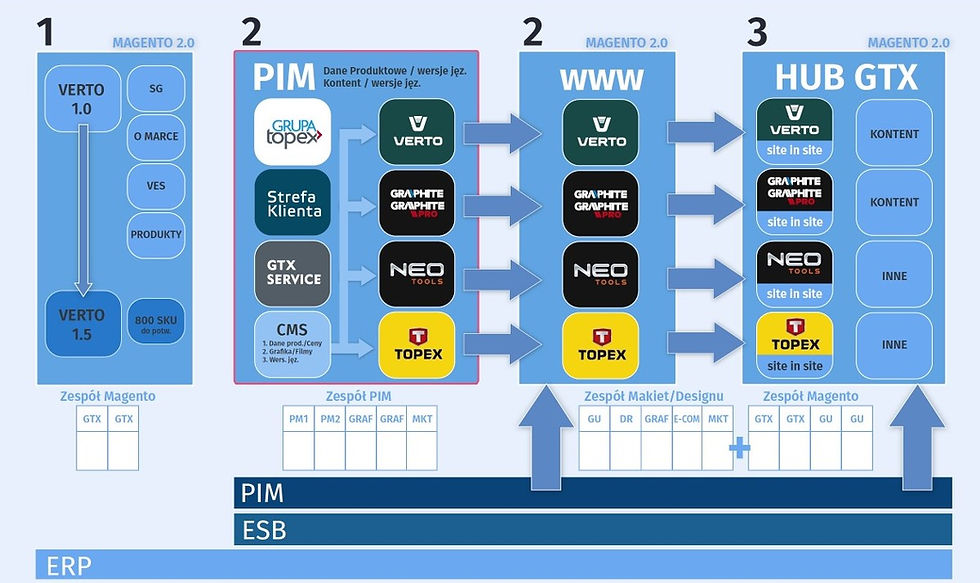E-commerce implementations - the bright and dark sides of the change process...
- OMNIBIZ Daniel Szafulera

- Jan 20
- 3 min read

Question: What challenge did e-commerce implementation pose for you and what did you do to overcome it?
Daniel Szafulera: E-commerce implementation, or rather the broader digitalization of a company and sales in a typical offline organization (i.e. based on the classic distribution model through brick-and-mortar stores), is the most complex process imaginable. Usually, the "trigger" is simply the desire to add e-com sales, but in a situation where we are dealing with a developed and conscious organization, such a process triggers a number of changes:
Firstly, DIGITAL STRATEGY
NOTE : Many organizations have their strategies, but very often when developing such a document, they do not pay much attention to the issue of DIGITAL TRANSFORMATION , not defining it as a MAIN/STRATEGIC GOAL. In companies based on OFFLINE sales, OFFLINE sales come to the forefront, and e-commerce, or more broadly, digitalization of the organization is not a priority. Therefore, as a solution complementing the COMPANY STRATEGY, I often recommend developing a separate document specifying the main goals of DIGITAL TRANSFORMATION/DIGITAL STRATEGY
In our case, these included:
modifications to the system architecture (ERP connection with PIM – Product Information Management System, introduction of the Data Bus, design of E-com B2B and E-com B2C),
transition to higher instances of the MAGENTO platform in the case of brand e-commerce,
designing a separate solution (both for USABILITY and USER INTERFACE) for B2B e-commerce (STREFA GTX) and B2C e-commerce (HUB GTX – tool marketplace)
Although in the first approach the priority was to build e-com B2C (separate brand and a common HUB - a'la tool marketplace), I ultimately changed this priority and the main activities in the second step were focused on launching e-commerce B2B (i.e. a platform for STORES, which to a large extent took over sales service previously carried out in the classic version by the Customer Service Department)
Part of the project team was involved in the work on architecture and functionality (CUSTOMER ZONES-GTX ZONES), the second, large group on tidying up the PRODUCT database (including supplementing or even creating product descriptions, including multilingual descriptions, supplementing the photo library, 5000 x 3 photos = 15,000 photos, and in many cases, for complex products, there were more photos, including 3D photos).
The next "track" was the work on content, including films, articles, actions in Social Media, Activations - this is one of the most difficult areas in the tools (time-consuming and very cost-intensive). Return on investment is very difficult to prove. All theories say: "CONTENT ONLY", "GOOD CONTENT is KEY", "CONTENT is KING", but the creators of these theories do not count the costs of creating content. For producers and distributors today, this is the lion's share of budgets.
Of course, a very important element of the entire process of implementing digital changes was the design process, testing solutions, presentations of subsequent stages, both within the project group and to the Management Board and to the Owners.
Many organizations forget about this element, and in a case where practically every area, every activity touches on a new specificity, a new issue, everyone is learning, it is necessary to maintain information/communication hygiene regarding both the idea, implementation stages and effects.
This of course extends the process, but in achieving greater digital awareness of the entire organization, it cannot be done by force or in a narrow group. Such large changes will not work if they are implemented only by a narrowly specialized "special task force."
In parallel with the entire revolution in the organisation of customer service processes (STREFA GTX), or the expansion of the E-COM B2C part, sales activities were underway to build the position of GRUPA TOPEX in the so-called e-BIZ, i.e. in external E-COM stores (including pure-players, such as: elektryk.pl, oleole, EURO RTV-AGD, others).
In addition, on the next track, work was underway on the construction of the GTX SERVICE platform offering spare parts, tool service, rental and other services related to tools (e.g. battery regeneration, etc.)
As you can see, the process was rather complex and multi-stage. It required a lot of consistency and determination in action, as well as support from the President, Owners, Management, and from the project groups. Definitely one of my more interesting professional experiences.
Want to know more? Write or call:
m: 511399274



















Comments